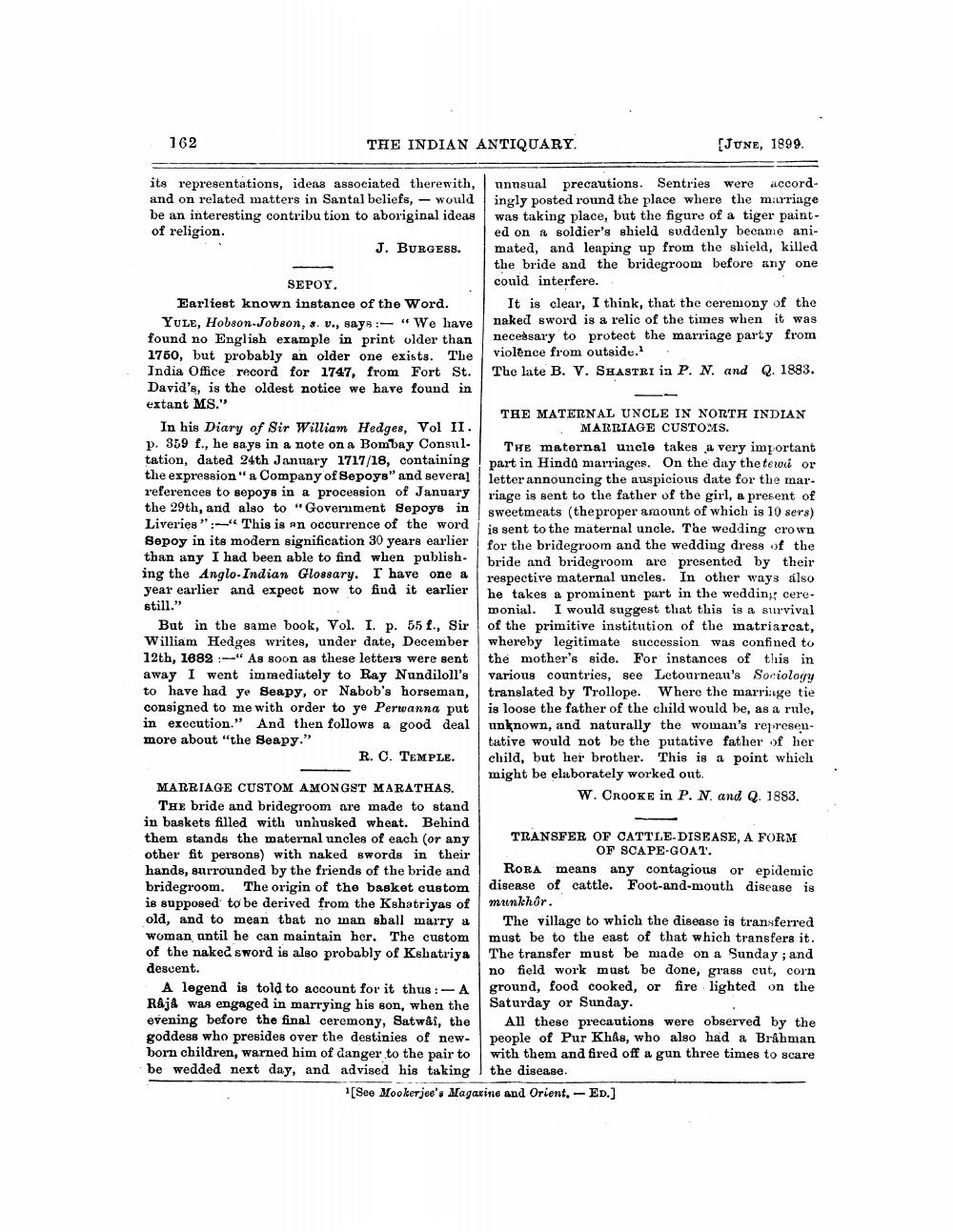________________
162
THE INDIAN ANTIQUARY.
[JUNE, 1899.
its representations, ideas associated therewith, unnsual precautions. Sentries were accordand on related matters in Santal beliefs, - wouldingly posted round the place where the marriage be an interesting contribution to aboriginal ideas was taking place, but the figure of a tiger paintof religion.
ed on a soldier's shield suddenly became aniJ. BURGESS. mated, and leaping up from the shield, killed
the bride and the bridegroom before any one SEPOY
could interfere. Earliest known instance of the Word. It is clear, I think, that the ceremony of the YULE, Hobson-Jobson, s. v., says:- “We have naked sword is a relic of the times when it was found no English example in print older than necessary to protect the marriage party from 1750, but probably an older one exists. The violence from outside. India Office record for 1747, from Fort St. The late B. V. SHASTRI in P. N. and Q. 1883. David's, is the oldest notice we have found in extant MS."
THE MATERNAL UNCLE IN NORTH INDIAN In his Diary of Sir William Hedges, Vol II. |
MARRIAGE CUSTOMS. p. 359 f., he says in a note on a Bombay Consul. | The maternal uncle takes a very important tation, dated 24th January 1717/18, containing part in Hindd marriages. On the day the tewi or the expression"a Company of Sepoys" and several letter announcing the auspicious date for the marreferences to sepoys in a procession of January
riage is sent to the father of the girl, a present of the 29th, and also to "Government Sepoys in
sweetmeats (the proper amount of which is 10 sers) Liveries":"This is an occurrence of the word
is sent to the maternal uncle. The wedding crown Sepoy in its modern signification 30 years earlier
for the bridegroom and the wedding dress of the than any I had been able to find wlien publish
bride and bridegroom are presented by their ing the Anglo-Indian Glossary. I have one a
respective maternal uncles. In other ways also year earlier and expect now to find it earlier he takes a prominent part in the wedding cerestill."
monial. I would suggest that this is a survival But in the same book, Vol. I. p. 55 f., Sir of the primitive institution of the matriarcat, William Hedges writes, under date, December whereby legitimate succession was confined to 12th, 1682 :-"As soon as these letters were sent the mother's side. For instances of this in away I went immediately to Ray Nundiloll's various countries, see Letourneau's Sociology to have had ye Seapy, or Nabob's horseman, translated by Trollope. Where the marriage tie consigned to me with order to ye Perwanna put is loose the father of the child would be, as a rule, in execution." And then follows a good deal unknown, and naturally the woman's represenmore about "the Seapy."
tative would not be the putative father of her R. C. TEMPLE child, but her brother. This is a point which
might be elaborately worked out. MARRIAGE CUSTOM AMONGST MARATHAS.
W. CROOKE in P. N. and Q. 1883. The bride and bridegroom are made to stand in baskets filled with unhusked wheat. Behind them stands the maternal uncles of each (or any TRANSFER OF CATTLE-DISEASE, A FORM other fit persons) with naked swords in their
OF SCAPE-GOAT'. hands, surrounded by the friends of the bride and RORA means any contagious or epidemic bridegroom. The origin of the basket custom disease of cattle. Foot-and-mouth disease is is supposed to be derived from the Kshatriyas of matkhổr. old, and to mean that no man sball marry a The village to which the disease is transferred woman until he can maintain her. The custom must be to the east of that which transfers it. of the naked sword is also probably of Kshatriya The transfer must be made on a Sunday; and descent.
no field work must be done, grass cut, corn A legend is told to account for it thus :- A ground, food cooked, or firelighted on the Raja was engaged in marrying his son, when the Saturday or Sunday. evening before the final ceremony, Satwai, the All these precautions were observed by the goddess who presides over the destinies of new people of Pur Khis, who also had a Brahman born children, warned him of danger to the pair to with them and fired off a gun three times to scare be wedded next day, and advised his taking the disease
[See Mookerjee's Magazine and Orient. - ED.)




